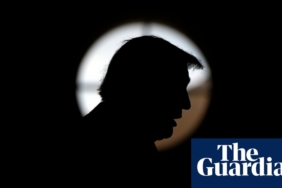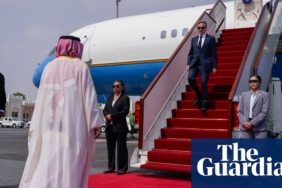President-elect Trump announced former acting ICE director Tom Homan (left) as his incoming border czar, joining a long list of presidents who have appointed czars to oversee specific issues — like Obama’s “car czar” Steven Rattner (right).
Drew Angerer/Getty Images
hide caption
toggle caption
Drew Angerer/Getty Images
Like it or not, the term “border czar” keeps coming up.
Throughout the election cycle, Republicans referred to — and criticized — Vice President Harris as one, despite the fact that she was never officially tasked with repairing the U.S.-Mexico border.
Now, President-elect Donald Trump says he plans to install one. One of his first personnel announcements was that Tom Homan, the former acting head of Immigration and Customs Enforcement, will rejoin his second administration in that role.
As border czar, Homan would be in charge of “the Southern Border, the Northern Border, all Maritime, and Aviation Security” as well as “all Deportation of Illegal Aliens back to their Country of Origin,” Trump wrote, though it’s unclear exactly how that will work.
In appointing a czar, Trump is continuing a decades-long presidential tradition — one that aims to solve problems quickly but hasn’t always been well-received or even well-defined.
“‘Czar’ is a relatively amorphous term because it’s used in the media so fast and loosely,” says Mitch Sollenberger, a professor of political science at the University of Michigan-Dearborn and co-author of the 2012 book The President’s Czars: Undermining Congress and the Constitution.
Nowadays, the term czar is used — sometimes by headline writers, sometimes by the White House — to describe an official that a president designates to coordinate the government’s response to a specific issue, usually one that is time-sensitive.
Presidents have used them in recent decades to address everything from drug proliferation to human trafficking, AIDS, cybersecurity, rubber, the Middle East, the Great Lakes and Asian Carp (yes, the invasive fish species). Trump installed at least one during his first term, to oversee the development of COVID-19 vaccines.
While the practice is relatively common, Sollenberger says, it can be controversial. The founders specifically didn’t want presidents to have the power to create offices without oversight, the way kings did.
“One of the problematic things about czars is if you are creating these positions out of thin air, you’re giving them whatever authority without any kind of paper trail,” he says, adding that those concerns are especially relevant given Trump’s very public designs on expanding presidential power.
Czars, he says, could be seen as one of several attempts by Trump to install his chosen officials — a list of names that have shocked and alienated even some in his own party — without going through the standard vetting process. Another example would be Trump’s public push for Senate Republican leadership to allow recess appointments, which would allow him to install some nominees without Senate confirmation.
“Unilateral executive action — Trump didn’t start this,” he adds. “But is Trump going to put this on steroids?”
Here’s a look at how czars fit into that picture.
Where did the term come from?
Sollenberger and his co-author, Mark Rozell, have defined a czar as a “non-Senate confirmed position that has final decision-making authority over budgets, policy areas [and] can promulgate rules, regulations as well that impact other government officials and even the private sector.”
But the term has a much longer history.
The word comes from “tsar,” the title for a Russian ruler or emperor (itself derived from the Latin word “caesar”), and migrated to the U.S. as an epithet for a power-hungry leader.
It originated — from the Latin word “caesar” — as the title for a Russian ruler or emperor, and migrated to the U.S. as a sort of epithet for a power-hungry leader and migrated to the U.S. as an epithet for a power-hungry leader.
One of its first recipients was Nicholas Biddle, who served as president of the Bank of the United States from 1823 to 1836 and clashed with President Andrew Jackson in the political conflict known as the “Bank War.”
The publisher of the Washington Globe, a Jackson ally, dubbed Biddle “Czar Nicholas,” according to Slate — an especially cutting moniker as Russia’s Nicholas I was in power at the time.
After the 1917 Russian Revolution — during which the last tzar, Nicholas II, abdicated the throne — the term started popping up in other contexts.
Kenesaw Mountain Landis, the first commissioner of Major League Baseball, became known as the “Czar of Baseball.” Per Slate, New York had both a boxing czar (the Athletic Commission chairman) and a beer czar (the Alcoholic Beverage Control Board chairman).
Which presidents have used czars?
The concept of a czar only reached the federal government during World War I, under President Woodrow Wilson.
Sollenberger says that’s in part because Congress passed the Overman Act, giving the president the authority to create government agencies and positions to respond to the war.
One of them was the War Industries Board, which coordinated the production of war supplies. It was overseen by financier Bernard Baruch, a powerful figure who came to be known as the “industry czar.”
“It makes logical sense for presidents to create these positions or to fill a public policy hole that necessarily wouldn’t be filled quickly if they went to Congress or tried to get Congress to fashion a particular law that not only properly authorized but created either a position or an agency,” Sollenberger says. “Those things don’t just take weeks or months. Those things take usually years.”
The use of czars has ebbed and flowed since then, according to Sollenberger. Some presidents had none, while others had many.
“It’s a power that isn’t necessarily exercised uniformly by each administration,” Sollenberger says. “If you look at the czars … it’s done during these emergency circumstances, primarily, where the president feels like there is this need, and we need to do this and we need to find somebody.”
Franklin Roosevelt had dozens, he says, to oversee various aspects of the response to WWII, from shipping to synthetic rubber to food prices to censorship.
Decades later, Richard Nixon named an energy czar to address the oil embargo and gas shortages. Several presidents, including Ronald Reagan and George H.W. Bush, tapped officials to serve as drug czars.
And there was another uptick in czars under Bill Clinton, who appointed officials to handle issues ranging from the federal bank bailout to nuclear cleanup to bird flu, according to Government Executive.
The president who had the most czars — and czar-related controversy — in recent memory is Barack Obama, who had by some counts nearly 30, for issues like climate, terrorism, green jobs, the closure of the Guantanamo Bay detention center and the auto bailout (even though his administration sought to clarify in 2009 that it wasn’t an official job title).
Obama’s perceived reliance on czars drew scrutiny from Republican lawmakers, who argued that he was dodging congressional oversight. It prompted a 2009 hearing on the history and legality of executive branch czars, as well as this quip from Republican Sen. John McCain: “Obama has more czars than the Romanovs” (Politifact rated that true).
What are the pros and cons of czars?
The advantage of czars is their “unity of purpose” and ability to address issues quickly, Sollenberger says.
“Particularly … in emergency circumstances, people want action, they want the problem to be addressed,” he adds. “And the solution to these problems is through some kind of concrete or specific type of individual authority.”
In the case of a border czar, for instance, he says that while there are already officials and agencies with the statutory authority to address immigration, taking action by labeling somebody a czar offers “a little bit more political benefit” to the president.
The downside, he says, is that the position of a czar isn’t rooted in the constitution or laws — so if their actions result in private harm, they could be sued. Plus, a president who installs multiple czars is likely to pay an internal political price, with competing spheres of influence and infighting between czars and agency or department heads.
And overall, he says, the effect of a czar is relatively temporary compared to that of someone like a Senate-approved cabinet secretary.
“It’s why executive orders are oftentimes seen as … lesser than going to Congress and trying to get something permanently done,” he adds. “That’s the same thing with czars in that respect.”
Sollenberger says a characteristic of czars is that they have a fairly high turnover rate, with most lasting only several years. He sees that as a source of comfort.
“Even though these people are not created through law, [and] they can exercise a significant amount of authority, they’re only going to be here for a second,” he says. “So maybe that should at least calm some fears.”









Yorumlar kapalı.